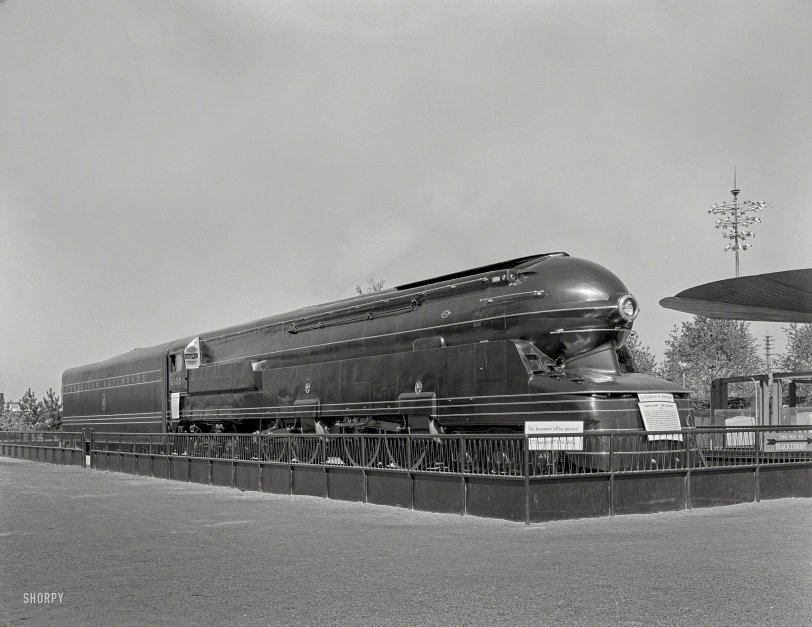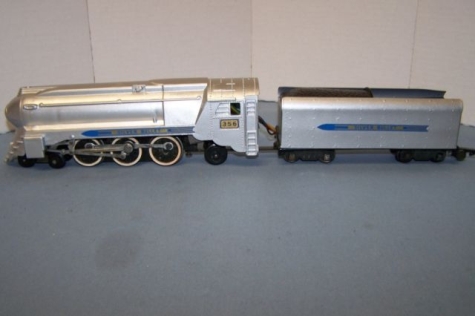


Framed or unframed, desk size to sofa size, printed by us in Arizona and Alabama since 2007. Explore now.
Shorpy is funded by you. Patreon contributors get an ad-free experience.
Learn more.

- If You’re Like Me, Never
- U.S.A.
- S&P
- 1940 Zenith radio model 6G601
- Quality goes in before the name goes on!
- Snazzy skirt
- Carbon Arc Lamps
- Illuminate us
- I remember it well
- I can't prove it
- Complicated then, forgotten now
- Bryan-Stevenson
- Skinny is as skinny does
- How do you rest in peace
- Riding the footboards
- Alas, hidden from view
- Baldwin Diesels
- Exclusive pump
- Bananas, Oysters and Smokey Joe
- Details, Details
- What's that building to the left of the tower?
- Coal Barges
- Bromo-Seltzer
- Inner harbor
- The Basin
- What a headache!
- Giant stepladder?
- Yeah, it was cold
- Love those coats
- Link & Pin Days Remnant
Print Emporium
Locomotive of Tomorrow: 1939

July 19, 1939. "New York World's Fair, railroad exhibit locomotives. Locomotive of Tomorrow, general view." Up next: The Caboose of Next Wednesday. Large-format acetate negative by Gottscho-Schleisner. View full size.
Moving Pictures! In Color!
This is a little late, but I found this one.
Going nowhere fast
Hey Lost World, There are numerous personal and newsreel films at Archive.org that show the 1939 World's Fair.
This one has a brief scene of this train running on the rollers! Look at about the 8:00 minute mark.
https://archive.org/details/72342NewYorkWorldsFairWorldOfTomorrow
Dave, Please!
Please tell me that this photo is just a teasing prelude to the one you're going to post of the S-1 running on the rollers. In 30+ years of researching steam locomotives I have yet to run across a decent photo of this. It must have been quite a spectacle.
Hank R. had this to say about that
I guess you know, it was actually up on rollers, and at times was run in place (see the sign). I can remember being a little scared walking by in front of it when it was running! (I was 7 or 8 then).
That canopy to the right was part of a Budd display. They also had a stainless steel wind sock at the top of a pole there, with the Budd name sand-etched into it. That was still there until they started clearing things for the 64 fair.
Note the LIRR transmission tower in the background - Port Wash branch west of Worlds Fair station later "UN", then WF again, then Shea Stadium station.
Thanks to Shorpy
I invested about an hour investigating Raymond Loewy, in general, this locomotive in particular, (and the proper spelling of Hercule Poirot.)
Not exactly "impractical" as flawed.
The S1 wasn't so much impractical, as it had some serious design flaws in it. Chief among those flaws was the rigid frame, which as Dbell said limited the curves which the locomotive could operate on. What's more, it was longer than many of the turntables along the route it was meant to operate on, meaning it needed to be turned by way of a wye track. Problem was, those tracks often had rather sharp curves (relatively speaking that is) and this meant that the S1 couldn't turn itself around. Probably the most damaging design flaw was the relatively low weight on the drivers. The S1 had less than half its total weight on the driving wheels, the rest being carried by the massive six-wheel pilot (leading) and trailing truck. This left the two sets of four duplex driving wheels susceptible to wheel slippage, a dangerous condition for any steam locomotive.
American Flyer Silver Bullet
Gilbert's American Flyer Silver Bullet from the late 40' and early 50's was based on this design. This was one of the last AF train that used link couplers.

Not scrapped
One streamlined steam locomotive that did survive is this N&W 4-8-4 that was built in the Roanoke shops, lost the battle to diesel electrics, was retired but used in excursion duty until 1994 (my photo made at Marion, VA is of its last run on the Bristol line), put into static display at the Transportation Museum of Virginia but this month after an extensive refurbishing in Spencer, NC returns to the mainline rails under its own power thanks to the campaign to Fire Up 611 and financial help from the Norfolk Southern Corporation.

Flash Gordon
The design reminds me a lot of the space ships in the old Flash Gordon comics!
Beautiful Styling
So much more attractive than the locomotive of today.
Memories
I had a Lionel train as a child in the early 50's that was the model of this engine. Wonder what ever happened to it?
























On Shorpy:
Today’s Top 5